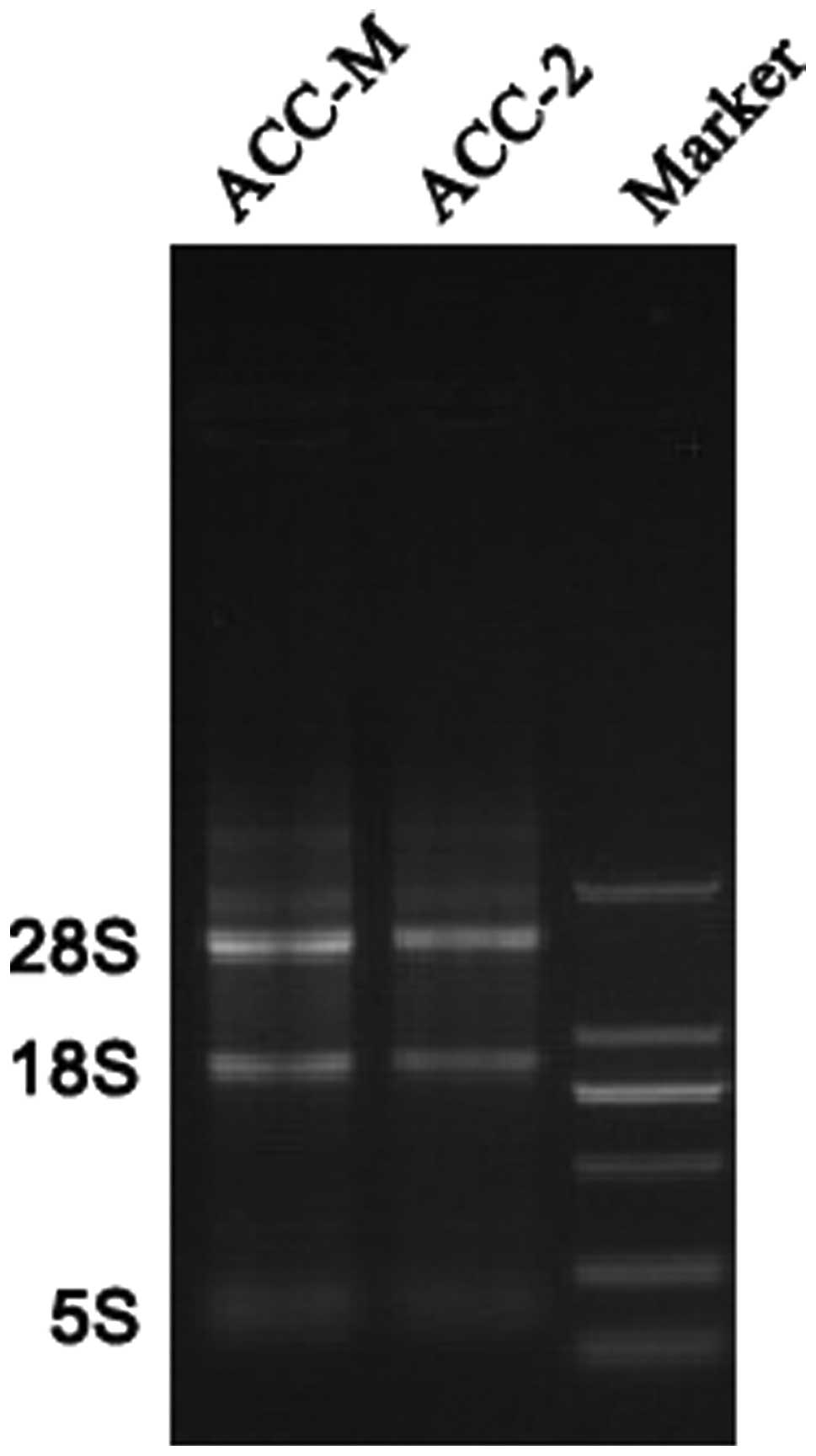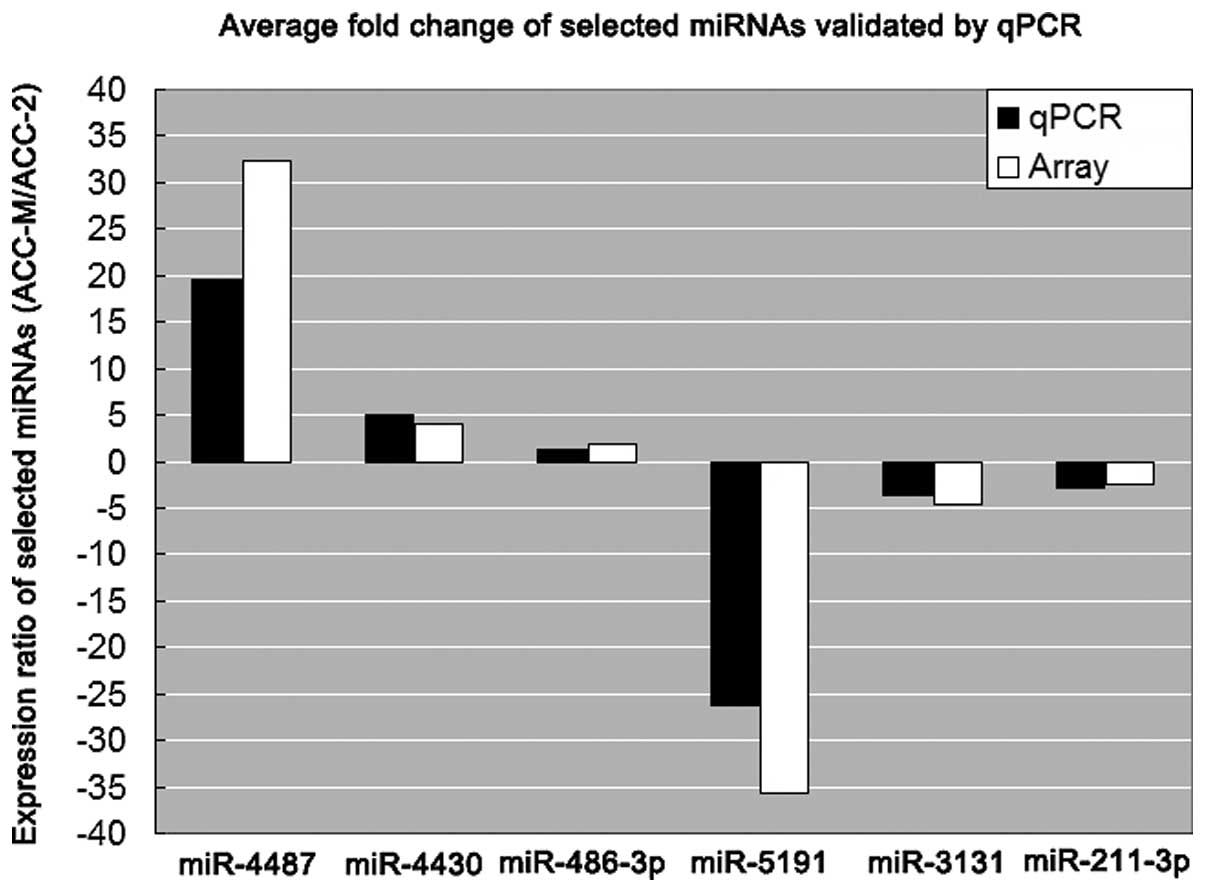|
1
|
Renehan A, Gleave EN, Hancock BD, Smith P
and McGurk M: Long-term follow-up of over 1000 patients with
salivary gland tumours treated in a single centre. Br J Surg.
83:1750–1754. 1996. View Article : Google Scholar : PubMed/NCBI
|
|
2
|
Anderson JN Jr, Beenken SW, Crowe R, Soong
SJ, Peters G, Maddox WA and Urist MM: Prognostic factors in minor
salivary gland cancer. Head Neck. 17:480–486. 1995. View Article : Google Scholar : PubMed/NCBI
|
|
3
|
van der Wal JE, Becking AG, Snow GB and
van der Waal I: Distant metastases of adenoid cystic carcinoma of
the salivary glands and the value of diagnostic examinations during
follow-up. Head Neck. 24:779–783. 2002.PubMed/NCBI
|
|
4
|
Ramer N, Wu H, Sabo E, Ramer Y, Emanuel P,
Orta L and Burstein DE: Prognostic value of quantitative p63
immunostaining in adenoid cystic carcinoma of salivary gland
assessed by computerized image analysis. Cancer. 116:77–83.
2010.PubMed/NCBI
|
|
5
|
Chen W, Zhang HL, Shao XJ, Jiang YG, Zhao
XG, Gao X, Li JH, Yang J, Zhang YF, Liu BL and Sun MY: Gene
expression profile of salivary adenoid cystic carcinoma associated
with perineural invasion. Tohoku J Exp Med. 212:319–334. 2007.
View Article : Google Scholar : PubMed/NCBI
|
|
6
|
Nakashima D, Uzawa K, Kasamatsu A, Koike
H, Endo Y, Saito K, Hashitani S, Numata T, Urade M and Tanzawa H:
Protein expression profiling identifies maspin and stathmin as
potential biomarkers of adenoid cystic carcinoma of the salivary
glands. Int J Cancer. 118:704–713. 2006. View Article : Google Scholar
|
|
7
|
Chen W, Zhang H, Wang J, Cao G, Dong Z, Su
H, Zhou X and Zhang S: Lentiviral-mediated gene silencing of
Notch-4 inhibits in vitro proliferation and perineural
invasion of ACC-M cells. Oncol Rep. 29:1794–1804. 2013.
|
|
8
|
Ding LC, She L, Zheng DL, Huang QL, Wang
JF, Zheng FF and Lu YG: Notch-4 contributes to the metastasis of
salivary adenoid cystic carcinoma. Oncol Rep. 24:363–368.
2010.PubMed/NCBI
|
|
9
|
Yang X, Zhang P, Ma Q, Kong L, Li Y, Liu B
and Lei D: EMMPRIN silencing inhibits proliferation and perineural
invasion of human salivary adenoid cystic carcinoma cells in
vitro and in vivo. Cancer Biol Ther. 13:85–91. 2012.
View Article : Google Scholar : PubMed/NCBI
|
|
10
|
Luukkaa H, Klemi P, Hirsimäki P, Vahlberg
T, Kivisaari A, Kähäri VM and Grénman R: Matrix metalloproteinase
(MMP)-1, -9 and -13 as prognostic factors in salivary gland cancer.
Acta Otolaryngol. 128:482–490. 2008. View Article : Google Scholar : PubMed/NCBI
|
|
11
|
Hao L, Xiao-lin N, Qi C, Yi-ping Y,
Jia-quan L and Yan-ning L: Nerve growth factor and vascular
endothelial growth factor: retrospective analysis of 63 patients
with salivary adenoid cystic carcinoma. Int J Oral Sci. 2:35–44.
2010. View Article : Google Scholar : PubMed/NCBI
|
|
12
|
Costa AF, Tasso MG, Mariano FV, Soares AB,
Chone CT, Crespo AN, Fresno MF, Llorente JL, Suárez C, de Araújo
VC, Hermsen M and Altemani A: Levels and patterns of expression of
hypoxia-inducible factor-1α, vascular endothelial growth factor,
glucose transporter-1 and CD105 in adenoid cystic carcinomas with
high-grade transformation. Histopathology. 60:816–825. 2012.
|
|
13
|
Chekanova JA and Belostotsky DA: MicroRNAs
and messenger RNA turnover. Methods Mol Biol. 342:73–85.
2006.PubMed/NCBI
|
|
14
|
Lages E, Ipas H, Guttin A, Nesr H, Berger
F and Issartel JP: MicroRNAs: molecular features and role in
cancer. Front Biosci (Landmark Ed). 17:2508–2540. 2012. View Article : Google Scholar
|
|
15
|
Li C, Hashimi SM, Good DA, Cao S, Duan W,
Plummer PN, Mellick AS and Wei MQ: Apoptosis and microRNA
aberrations in cancer. Clin Exp Pharmacol Physiol. 39:739–46. 2012.
View Article : Google Scholar : PubMed/NCBI
|
|
16
|
Nishizawa T and Suzuki H: The role of
microRNA in gastric malignancy. Int J Mol Sci. 14:9487–9496. 2013.
View Article : Google Scholar : PubMed/NCBI
|
|
17
|
Wu WK, Lee CW, Cho CH, Fan D, Wu K, Yu J
and Sung JJ: MicroRNA dysregulation in gastric cancer: a new player
enters the game. Oncogene. 29:5761–5771. 2010. View Article : Google Scholar : PubMed/NCBI
|
|
18
|
Guan XF, Qiu WL, He RG and Zhou XJ:
Selection of adenoid cystic carcinoma cell clone highly metastatic
to the lung: an experimental study. Int J Oral Maxillofac Surg.
26:116–119. 1997. View Article : Google Scholar : PubMed/NCBI
|
|
19
|
Vela J, Vitorica J and Ruano D: Rapid
PCR-mediated synthesis of competitor molecules for accurate
quantification of beta(2) GABA(A) receptor subunit mRNA. Brain Res
Brain Res Protoc. 8:184–190. 2001. View Article : Google Scholar : PubMed/NCBI
|
|
20
|
Brazma A, Hingamp P, Quackenbush J,
Sherlock G, Spellman P, Stoeckert C, Aach J, Ansorge W, Ball CA,
Causton HC, et al: Minimum information about a microarray
experiment (MIAME)-toward standards for microarray data. Nat Genet.
29:365–371. 2001. View Article : Google Scholar : PubMed/NCBI
|
|
21
|
Liu SG, Qin XG, Zhao BS, Qi B, Yao WJ,
Wang TY, Li HC and Wu XN: Differential expression of miRNAs in
esophageal cancer tissue. Oncol Lett. 5:1639–1642. 2013.PubMed/NCBI
|
|
22
|
Margue C, Philippidou D, Reinsbach SE,
Schmitt M, Behrmann I and Kreis S: New target genes of MITF-induced
microRNA-211 contribute to melanoma cell invasion. PLoS One.
8:e734732013. View Article : Google Scholar : PubMed/NCBI
|
|
23
|
Nikitina EG, Urazova LN and Stegny VN:
MicroRNAs and human cancer. Exp Oncol. 34:2–8. 2012.
|
|
24
|
Matsuba HM, Spector GJ, Thawley SE,
Simpson JR, Mauney M and Pikul FJ: Adenoid cystic salivary gland
carcinoma. A histopathologic review of treatment failure patterns.
Cancer. 57:519–524. 1986. View Article : Google Scholar : PubMed/NCBI
|
|
25
|
Kim KH, Sung MW, Chung PS, Rhee CS, Park
CI and Kim WH: Adenoid cystic carcinoma of the head and neck. Arch
Otolaryngol Head Neck Surg. 120:721–726. 1994. View Article : Google Scholar : PubMed/NCBI
|
|
26
|
Wiseman SM, Popat SR, Rigual NR, Hicks WL
Jr, Orner JB, Wein RO, McGary CT and Loree TR: Adenoid cystic
carcinoma of the paranasal sinuses or nasal cavity: a 40-year
review of 35 cases. Ear Nose Throat J. 81:510–517. 2002.PubMed/NCBI
|
|
27
|
Fordice J, Kershaw C, El-Naggar A and
Goepfert H: Adenoid cystic carcinoma of the head and neck:
predictors of morbidity and mortality. Arch Otolaryngol Head Neck
Surg. 125:149–152. 1999. View Article : Google Scholar : PubMed/NCBI
|
|
28
|
Sequeiros-Santiago G, García-Carracedo D,
Fresno MF, Suarez C, Rodrigo JP and Gonzalez MV: Oncogene
amplification pattern in adenoid cystic carcinoma of the salivary
glands. Oncol Rep. 21:1215–1222. 2009.PubMed/NCBI
|
|
29
|
He Q, Zhou X, Li S, Jin Y, Chen Z, Chen D,
Cai Y, Liu Z, Zhao T and Wang A: MicroRNA-181a suppresses salivary
adenoid cystic carcinoma metastasis by targeting MAPK-Snai2
pathway. Biochim Biophys Acta. 1830:5258–5266. 2013. View Article : Google Scholar : PubMed/NCBI
|
|
30
|
Mitani Y, Roberts DB, Fatani H, Weber RS,
Kies MS, Lippman SM and El-Naggar AK: MicroRNA profiling of
salivary adenoid cystic carcinoma: association of miR-17–92
upregulation with poor outcome. PLoS One. 8:e667782013.PubMed/NCBI
|
|
31
|
Liu L, Hu Y, Fu J, Yang X and Zhang Z:
MicroRNA155 in the growth and invasion of salivary adenoid cystic
carcinoma. J Oral Pathol Med. 42:140–147. 2013. View Article : Google Scholar : PubMed/NCBI
|
|
32
|
Pinós T, Barbosa-Desongles A, Hurtado A,
Santamaria-Martínez A, de Torres I, Reventós J and Munell F: Human
SHBG mRNA translation is modulated by alternative 5′-non-coding
exons 1A and 1B. PLoS One. 5:e138442010.PubMed/NCBI
|
















